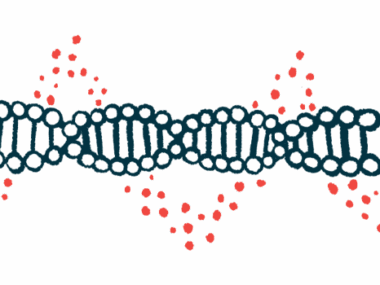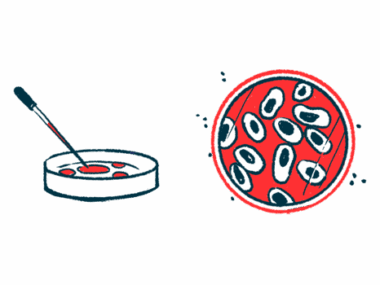Polymer-based treatment slows Huntington’s disease onset in mice
Researchers now aim to test P1 polymer in lab-grown cells from patients
Written by |

Researchers have developed a protein-like polymer — a large, string-like molecule composed of small repeating building blocks — that was able to slow the onset of Huntington’s disease in a mouse model.
In the mice, the protein-like polymer prevented the clumping of misfolded huntingtin protein that drives nerve cell death in Huntington’s, according to a new study by the researchers, from Northwestern University in Illinois.
“The misfolded proteins interact and aggregate [clump up]. We’ve developed a polymer that can fight those interactions,” Nathan Gianneschi, PhD, the study’s co-senior author and a professor of chemistry, materials science and engineering, biomedical engineering, and pharmacology at Northwestern, said in a university news story.
By disrupting huntingtin’s toxic aggregation, the polymer-based therapy significantly lessened motor deficits and prolonged survival in a Huntington’s mouse model without causing toxicity, the researchers noted. It also slowed the onset of Huntington’s disease in the mice.
Their study, “Proteomimetic polymer blocks mitochondrial damage, rescues Huntington’s neurons, and slows onset of neuropathology in vivo,” was published in the journal Science Advances.
Researchers team up to develop novel polymer, dubbed P1
The genetic defect that causes Huntington’s leads to the production of an abnormally long huntingtin protein, which is prone to form toxic clumps inside brain cells and cause damage. Symptoms include movement problems, loss of cognitive ability, and psychiatric changes.
“Huntington’s is a horrific, insidious disease,” and “there is no real treatment for stopping or reversing the disease, and there is no cure,” said Gianneschi. “So, we started thinking about a new way to address this disease.”
The mutant form of huntingtin is known to cause problems in mitochondria, the cell’s powerhouses, which ultimately triggers nerve cell death. Previous work by Case Western Reserve University researchers, in Ohio, showed that the valosin-containing protein, or VCP, binds to mutant huntingtin, triggering protein clumping within mitochondria.
As part of that study, led by Xin Qi, PhD, the team also discovered a naturally occurring peptide, or shorter protein, that bound to both VCP and mutant huntingtin at the same time. That peptide blocked their interaction and prevented mitochondrial dysfunction.
“Qi’s team identified a peptide that comes from the mutant protein itself and basically controls the protein-protein interface,” Gianneschi said. “That peptide inhibited mitochondrial death, so it showed promise.”
For the peptide to be used as a Huntington’s treatment, however, it must access the brain in large enough amounts to prevent protein aggregation. Moreover, most peptides can’t easily access cells; they are relatively small and are readily broken down in the body.
For this study, Gianneschi’s team joined forces with Qi and colleagues to develop a protein-like polymer, dubbed P1, to disrupt the interaction between mutant huntingtin and VCP.
Protein-like polymers comprise a string-like molecule attached to multiple peptide copies, like branches on a tree. This protects the peptides from being broken down and allows them to access the brain and enter cells.
Administration of the newly developed protein-like polymer to healthy mice showed that the therapy remained in the bloodstream at least 2,000 times longer than the single peptide attached to a cell-penetrating molecule as a comparison. That single peptide was no longer detectable after five minutes, according to the researchers.
Treatment slows onset, disease progression in Huntington’s mice
The team then used a Huntington’s mouse model to assess the effects of P1 treatment relative to no treatment. While untreated mice gradually lost weight and showed higher rates of death relative to healthy mice, treatment with P1 lessened this weight loss and significantly extended survival.
The progressive worsening of motor deficits seen in untreated Huntington’s mice was also attenuated with P1 treatment, as indicated by the hindlimb clasping test and the open field test.
In the hindlimb clasping test, animals are gently lifted by the tail, and the degree of hindlimb retraction, or clasping, toward the body — instead of the normal limb extension toward the surface — is an indicator of motor impairment. Treated mice exhibited significantly shorter times of hindlimb clasping relative to untreated animals.
In the open field test, animals are placed in a new, closed environment, such as a box, and their exploratory behaviors are assessed.
Treated animals with Huntington’s disease started to [explore a new space in one laboratory test]. It’s quite compelling when you see animals behave more normally than they would otherwise.
“In the animals with Huntington’s, as the disease progresses, they stay along the edges of the box,” Gianneschi said. Meanwhile, healthy animals “cross back and forth to explore the space.”
Here, the researcher noted, “the treated animals with Huntington’s disease started to do the same thing. It’s quite compelling when you see animals behave more normally than they would otherwise.”
Analyses of brain tissue from P1-treated Huntington’s mice showed that the therapy effectively suppressed mutant huntingtin aggregation and the abnormal movement of VCP into mitochondria. P1 also rescued medium spiny neurons, the brain nerve cells most susceptible to Huntington’s-associated degeneration.
Importantly, in healthy mice, the treatment had no significant effects on motor activity, body weight, or neurological function, “confirming a lack of toxicity of P1 treatment,” the team wrote.
The team now aims to test whether P1 has similar protective effects on lab-grown cells derived from Huntington’s patients.
“My childhood friend was diagnosed with Huntington’s at age 18 through a genetic test,” Gianneschi said. “He’s now in an assisted living facility because he needs 24-hour, full-time care. I remain highly motivated — both personally and scientifically — to continue traveling down the path.”






